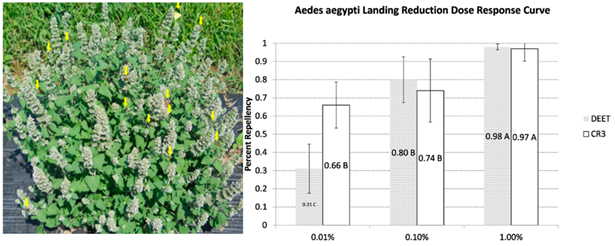
 A bar graph showing the dose-response landing inhibition curve for the mosquito species Aedes aegypti for the noted repellent treatments at 0.01%, 0.1%, and 1%. The treatments included DEET & N. cataria ‘CR3” crude essential oil.
A bar graph showing the dose-response landing inhibition curve for the mosquito species Aedes aegypti for the noted repellent treatments at 0.01%, 0.1%, and 1%. The treatments included DEET & N. cataria ‘CR3” crude essential oil.
Invention Summary:
Catnip is a short-lived perennial herb that contains a volatile oil dominated by nepetalactones. This oil is well known to provide euphoric effects on cats. Nepetalactones are also highly effective at repelling insects and thus can protect against insect-borne diseases. With climate change, warmer weather is fostering greater vector populations that are also increasingly immune to traditional DEET-based repellents.
Researchers at Rutgers have discovered a catnip Nepeta cataria cultivar called CR3 which expresses higher levels of essential oils than commercially available catnip suppliers. Additionally, this invention provides a plant that produces more E, Z- nepetalactone compared to currently available varieties, while still accumulating its isomer Z, E- nepetalactone. This isomer has the ability to elicit different behavioral responses of different insects and arthropods in reference to repellency. The cultivar is resistant to harsh winter conditions and can support large-scale essential oil production.
Market Applications:
- Insect and arthropod repellant against mosquitoes, ticks, and bed bugs.
- Pet toys.
- Catnip herbal tea.
Advantages:
- CR3 cultivar produces higher essential oils with consistent content than any other cultivar or commercial seed source.
- Highly resistant to weather.
- Produces the minor nepetalactone E,Z- nepetalactone in significantly higher concentrations than any commercial supplier.
Short video trailer: Biting Back: the life-saving potential of Catnip
Intellectual Property & Development Status: P
Issued US patents (10,512,231 & 10,952,390 B2). Available for licensing and/or search collaboration. For any business development and other collaborative partnerships contact marketingbd@research.rutgers.edu